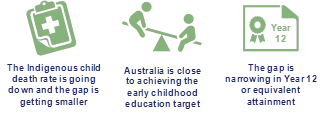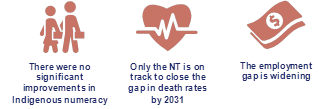Dr John Gardiner-Garden, Social Policy
Key issue
This article looks at the origins, objectives and effectiveness of the Closing the Gap initiative. |
What is ‘Closing the Gap’?
In his Social justice report 2005, Aboriginal and Torres Strait Islander Social Justice Commissioner Tom Calma urged Australian governments to commit to achieving equality for Indigenous people in health and life expectancy within 25 years. Non-government agencies responded to Calma’s appeal, developing a National Indigenous Health Equality Campaign in 2006, and launching a Close the Gap campaign in 2007. This rights-based awareness campaign later gave rise to a National Close the Gap Day, which helped inspire cross-government action.
The Council of Australian Governments (COAG) pledged to close key gaps in December 2007, and in March 2008 government and non-government delegates to a National Indigenous Health Equality Summit signed a statement of intent.
In July 2008, the Rudd Government established the National Indigenous Health Equality Council, and in November of that year COAG approved the National Indigenous Reform Agreement which set out six Closing the Gap targets:
- to close the life expectancy gap within a generation
- to halve the gap in mortality rates for Indigenous children under five within a decade
- to ensure access to early childhood education for all Indigenous four year olds in remote communities within five years
- to halve the gap in reading, writing and numeracy achievements for children within a decade
- to halve the gap for Indigenous students in year 12 attainment rates by 2020 and
- to halve the gap in employment outcomes between Indigenous and non-Indigenous Australians within a decade.
To help achieve these goals COAG identified a number of building blocks (early childhood, schooling, health, economic participation, healthy homes, safe communities and governance and leadership). It also facilitated a number of Indigenous-specific National Partnerships, namely:
What progress has been made?
Three publications track developments in Closing the Gap targets—the Prime Minister’s annual report (Closing the Gap: Prime Minister’s Report, 2013), the Productivity Commission’s biennial report (Overcoming Indigenous Disadvantage: Key Indicators 2011) and the COAG Reform Council’s report on progress (Indigenous Reform 2011-12: Comparing performance across Australia).
The COAG Reform Council’s report indicates that there has been good progress on three targets (child mortality rates, early childhood education, and year 12 or equivalent attainment), but results for the remaining three targets (overall life expectancy, academic achievement and employment outcomes) are less positive.


Source: COAG Reform Council, Indigenous Reform 2011–12: Comparing performance across Australia
How much is spent on Closing the Gap?
According to the Productivity Commission’s 2012 Indigenous Expenditure Report, total direct Indigenous expenditure was estimated to be $25.4 billion. This represents 5.6% of total direct government expenditure. Australian Government spending accounted for $11.5 billion of this expenditure (45% of the total). The estimated expenditure per head of population was $44,128 for Indigenous Australians, compared with $19,589 for other Australians.
How effective is this expenditure?
In assessing the progress of COAG’s Closing the Gap initiatives, commentators have noted that there are a number of problems. These include: data limitations, agreeing target progress points, measuring achieved trajectories across jurisdictions and the absence of targets in some areas (such as justice). For example, the target of closing the gap in life expectancy cannot be measured in some jurisdictions, it is subject to considerable debate on the methodology that should be used for determining Indigenous life expectancy and it is not responsive in the short term to interventions. Focussing on death rates is an interim alternative measure, but one still subject to considerable data limitations.
Commentators have also noted the difficulty of following funding lines to assess the efficacy of expenditure. As Jon Altman, professor at the Centre for Aboriginal Economic Policy Research, has observed in ‘Black government expenditure—it’s a white thing’, the Productivity Commission’s Indigenous Expenditure Report cannot reveal how much was spent on Closing the Gap – what was spent on service provision and what on administration, how effectively a service was delivered, or how much benefit Indigenous Australians garnered from the estimated expenditure.
Concerns over the efficacy of programs that are meant to be closing the gap featured prominently in the Finance Department’s Strategic Review of Indigenous expenditure (2010). The report noted:
The Commonwealth’s total expenditure on its Indigenous-specific programs amounts to some $3.5 billion annually. This major investment, maintained over many years, has yielded dismally poor returns to date.
Closing the Gap in the Northern Territory
Not to be confused with the COAG Closing the Gap initiative is ‘Closing the Gap in the Northern Territory’, which was part of the Howard Government’s 2007-initiated Northern Territory Emergency Response (NTER). In November 2009, the Rudd Government introduced legislation to reverse the suspension of the operation of the Racial Discrimination Act 1975, redefine ‘Income Management’ and address other elements of the NTER, later rebadged as ‘Closing the Gap in the Northern Territory’. In 2011, this range of measures was renamed ‘Stronger Futures in the Northern Territory’.
Further reading
J Gardiner-Garden and J Simon-Davies, Commonwealth Indigenous-specific expenditure 1968–2012, Background note, Parliamentary Library, Canberra, 28 September 2012.
For copyright reasons some linked items are only available to members of Parliament.
© Commonwealth of Australia